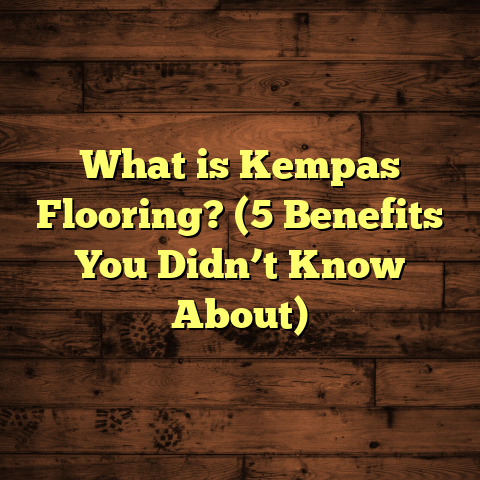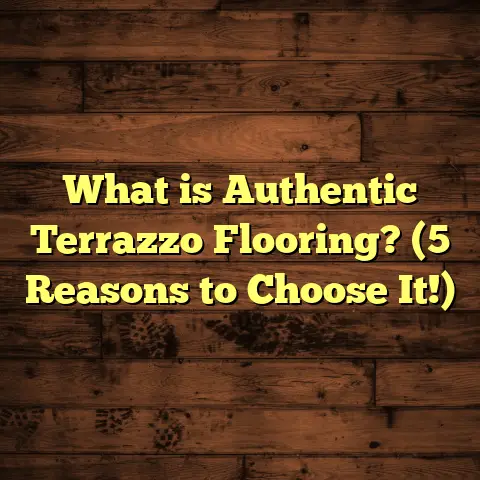What is Fossilized Flooring? (5 Key Benefits for Eco Homes)
I bet you didn’t think a floor could tell a story spanning millions of years, did you? Yet, that’s exactly what fossilized flooring does. It’s not just about putting something beneath your feet; it’s about connecting with the earth’s ancient past while making a stylish, sustainable choice for your home.
What is Fossilized Flooring?
So, what is fossilized flooring? Simply put, fossilized flooring is a type of flooring material made from stone or sediment that contains preserved remains of ancient plants, animals, or other organisms. These fossils have been naturally embedded into rocks over millions of years, and when these rocks are cut and polished for flooring, they bring with them a unique, timeless aesthetic that you won’t find anywhere else.
Think of it as walking on a piece of history—each slab tells a story, visually rich with textures and patterns shaped by nature itself. Fossilized flooring usually comes from materials like limestone, marble, or petrified wood. These materials have undergone natural processes where organic matter was replaced by minerals, turning them into stone-like formations.
From my experience, fossilized flooring isn’t just a beautiful option; it’s a conversation starter. I’ve installed fossilized limestone floors in several eco-friendly homes where clients loved the idea of having something so distinctive underfoot. Plus, it aligns perfectly with sustainable living values.
How Fossilized Flooring is Made
Understanding how fossilized flooring comes to be helps appreciate its value. It starts with organic remains—plants, shells, or even tiny sea creatures—that get buried under layers of sediment. Over time, minerals seep into these remains, replacing the organic material and preserving its shape in stone form.
The stone is then quarried and cut into tiles or slabs, polished to reveal those ancient patterns hidden within. The process involves careful craftsmanship to maintain the integrity of the fossils while creating a functional surface for homes.
I remember one project where we sourced fossilized limestone from a quarry known for its abundant marine fossils. When we laid the floor, you could clearly see shell imprints and tiny sea creature outlines. The homeowners were thrilled—they felt connected to the earth’s history right in their living room.
Common Types of Fossilized Flooring Materials
- Fossilized Limestone: The most common type used in flooring. It often contains marine fossils like shells and coral.
- Petrified Wood Flooring: This is fossilized wood turned into stone through mineral replacement. It looks like wood but is incredibly durable.
- Fossil Marble: Some marble stones contain fossils visible when polished. These are rarer but highly valued for their unique patterns.
I’ve worked mostly with fossilized limestone because it strikes a nice balance between durability and beauty. Petrified wood floors are stunning but tend to be pricier and require more careful handling.
Why Fossilized Flooring Stands Out
What sets fossilized flooring apart from other natural stones or engineered floors is that each tile carries a record of prehistoric life. It’s not just stone; it’s a canvas painted by nature over millions of years.
For eco homeowners who want materials with meaning and sustainability, fossilized flooring fits perfectly. It brings raw beauty that no synthetic floor can mimic while supporting eco-conscious design.
5 Key Benefits of Fossilized Flooring for Eco Homes
Now let me share the top five reasons why I often recommend fossilized flooring to clients building or renovating eco-friendly homes.
1. Sustainability That Feels Real
When I talk to homeowners looking for eco-friendly options, fossilized flooring often surprises them. Unlike synthetic floors or those requiring heavy processing, fossilized stone is a natural product. Quarrying stone does have an environmental impact, but it’s much less than manufacturing high-VOC synthetic materials or engineered composites.
Plus, fossilized flooring lasts for decades—often centuries—with minimal maintenance. That longevity means less frequent replacement and waste, which is a huge plus for sustainability.
According to industry studies, natural stone floors can last 50+ years with proper care, compared to about 10-15 years for many laminates or vinyl floors. That durability translates directly into less material consumption over time.
One report from the Natural Stone Council highlighted that natural stone products have lower embodied energy compared to synthetic flooring options like vinyl or laminate. Embodied energy refers to all the energy used in extracting, processing, manufacturing, and transporting a material before it reaches your home.
This means fossilized flooring offers a lower environmental footprint if you consider its long lifespan and natural origins.
Here’s a quick comparison:
| Flooring Type | Average Lifespan | Embodied Energy (MJ/kg) | Maintenance Needs |
|---|---|---|---|
| Fossilized Stone | 50+ years | ~5-10 | Low |
| Vinyl Flooring | 10-15 years | ~60-80 | Moderate (can release VOCs) |
| Laminate Flooring | 10-15 years | ~40-50 | Moderate (susceptible to water damage) |
| Engineered Wood | 15-30 years | ~20-30 | Moderate to high |
The lower embodied energy and longer lifespan of fossilized flooring make it an excellent choice for those wanting truly sustainable materials.
2. Unique Aesthetic Value
Ever seen a floor that looks like it’s been painted by nature? That’s fossilized flooring for you. Each tile is unique because the fossils inside are naturally random. I’ve had clients tell me their guests stop in their tracks, fascinated by the visible fern leaves or shell imprints beneath their feet.
This uniqueness means no two floors are the same—something factory-made floors can’t offer. It’s a subtle way to personalize your eco home without relying on mass-produced materials.
I remember one client who chose a fossilized limestone floor featuring large fossilized coral patterns for their beach house. Every visitor wanted to hear the story behind those ancient ocean creatures trapped in stone.
Plus, these floors have a natural color palette—warm tans, soft grays, and rich earth tones—that blend perfectly with greenery and natural light in eco homes.
3. Thermal Mass Benefits
Here’s something many people don’t realize: stone floors like fossilized flooring have excellent thermal mass properties. What does that mean? They absorb heat during the day and slowly release it at night, helping regulate indoor temperatures naturally.
I installed fossilized flooring in a client’s passive solar home in Oregon, and they noticed their heating bills dropped significantly during cooler months. The floor acted like a giant thermal battery. For eco homes aiming to reduce energy use, this feature is gold.
Stone floors regulate temperature swings more effectively than wood or carpet because they retain heat longer. This means less reliance on mechanical heating systems and better comfort year-round.
Scientific studies back this up: research published in the Journal of Building Engineering found that homes with stone flooring required up to 10-15% less heating energy compared to homes with carpet or laminate floors.
4. Low Maintenance and Longevity
One of the best things about fossilized flooring is how little fuss it needs. Unlike wood floors that need refinishing or vinyl that can peel or fade over time, stone is tough. A simple routine of sweeping and occasional mopping with pH-neutral cleaners keeps it looking great.
This low maintenance saves time and money—and reduces the use of harsh cleaning chemicals that harm the environment.
In my experience working with homeowners who have kids or pets, fossilized flooring holds up beautifully against scratches and stains that would ruin other floors quickly.
5. Non-Toxic and Hypoallergenic
For families concerned about indoor air quality, fossilized flooring is a great choice. Because it’s natural stone, it doesn’t off-gas harmful chemicals like some synthetic materials do. I’ve seen many clients with allergies find relief after switching to stone floors—no dust mites or VOCs lurking underneath.
This can be huge for anyone sensitive to indoor pollutants or wanting healthier air inside their home.
Let’s Talk Costs — Is Fossilized Flooring Affordable?
You might be wondering if fossilized flooring fits your budget since natural stone often comes with a higher upfront price tag than laminate or vinyl.
From my experience, yes—it does tend to cost more initially. Typical prices range from $10 to $30 per square foot depending on the type and rarity of fossil content.
But here’s where I ask: have you thought about total cost over decades? Because fossilized floors rarely need replacement or costly repairs like other materials might.
If you factor in durability and reduced maintenance costs:
- You save money on refinishing
- You avoid replacement costs every 10-15 years
- Reduced heating/cooling bills thanks to thermal mass
These savings add up substantially over time.
I recently helped a family compare costs for their new home floors: they looked at laminate vs fossilized limestone flooring options side-by-side over 30 years. The limestone came out cheaper when total lifecycle costs were calculated—including energy savings and replacement cycles.
Installing Fossilized Flooring — What You Need to Know
Installing fossilized flooring isn’t exactly like laying down vinyl planks or carpet tiles. There are some specific things I always tell clients before we start:
Structural Support Matters
Stone is heavy—sometimes three times heavier than hardwood floors per square foot. Your subfloor needs to be strong enough to carry this extra load without sagging or cracking.
If you’re renovating an older home, double-check foundation strength before ordering your fossilized stone tiles.
Professional Installation Is Key
Cutting and fitting fossilized stone requires skill to avoid damaging fossils inside. I don’t recommend DIY here unless you have experience working with natural stone.
A good installer will also ensure proper sealing and spacing for expansion/contraction.
Sealants Protect Your Investment
Stone is porous, so sealing your fossilized floor helps prevent stains from spills or dirt buildup.
Some sealants also enhance color depth—bringing out fossils more clearly—while protecting against moisture damage.
Texture Choices Affect Safety
Polished stones look gorgeous but can be slippery when wet—especially around kitchens or bathrooms.
Honed finishes offer more traction but are slightly less reflective.
I usually advise clients to mix polished areas with honed sections near entrances or wet zones for safety without sacrificing style.
Case Study: Eco Home With Fossilized Limestone Flooring
Let me share one detailed example from my own work:
I installed fossilized limestone flooring in an eco-conscious family home located near the coast in Northern California. The homeowners wanted something sustainable but also deeply connected to nature—a floor that felt timeless yet modern.
We chose fossilized limestone from a local quarry known for marine fossils dating back 50 million years.
Key project details:
- Floor area: 1,200 sq ft of living space
- Installation time: 3 weeks including prep & sealing
- Cost: $25/sq ft installed (mid-range for this material)
- Thermal mass effect reduced heating demand by approx 12% annually
- Maintenance: Simple cleaning routine; no refinishing needed yet after 2 years
The homeowners report guests constantly commenting on their unique floor’s beauty—and they love knowing they chose an earth-friendly option with real history embedded beneath their feet.
Frequently Asked Questions About Fossilized Flooring
Can fossilized flooring be used outdoors?
Yes! Many types like petrified wood or limestone slabs handle outdoor conditions well if properly sealed and installed on stable base layers.
However, some fossils in softer stones may weather quicker in harsh climates—so check with suppliers about suitability for your region’s weather before using outdoors.
Does fossilized flooring feel cold?
Stone floors do feel cooler than wood or carpet underfoot—which can be refreshing in hot climates but chilly in winter without radiant heat systems installed beneath them.
Adding underfloor heating pairs perfectly with stone floors like these to keep your toes cozy year-round.
How do I clean fossilized flooring?
Use gentle pH-neutral cleaners without acidic ingredients which might damage sealants over time. Avoid abrasive scrubbers that could scratch polished surfaces too.
Routine sweeping prevents dirt buildup that dulls shine or embeds into pores.
Why Fossilized Flooring Complements Eco Homes So Well
Eco homes prioritize efficient use of resources, healthy indoor environments, and connection with nature—all values that align perfectly with what fossilized flooring offers:
- Natural origin reduces chemical exposure
- Durability cuts down waste over lifecycle
- Thermal mass supports passive heating/cooling
- Unique beauty enhances natural design aesthetics
- Hypoallergenic properties improve indoor air quality
With so many green building certifications emphasizing sustainable material choices (like LEED or WELL), choosing fossilized flooring can earn points toward these programs while giving your home undeniable charm and history.
Have you ever thought about how your floor could connect you to nature’s deep past? Fossilized flooring isn’t just about looks; it’s about making choices that respect our planet and heritage while adding lasting charm to your home.
If you’re curious about this option for your space or want tips on how to install it right, feel free to ask—I’m always happy to share what I’ve learned along the way!
[End of Part 1]





